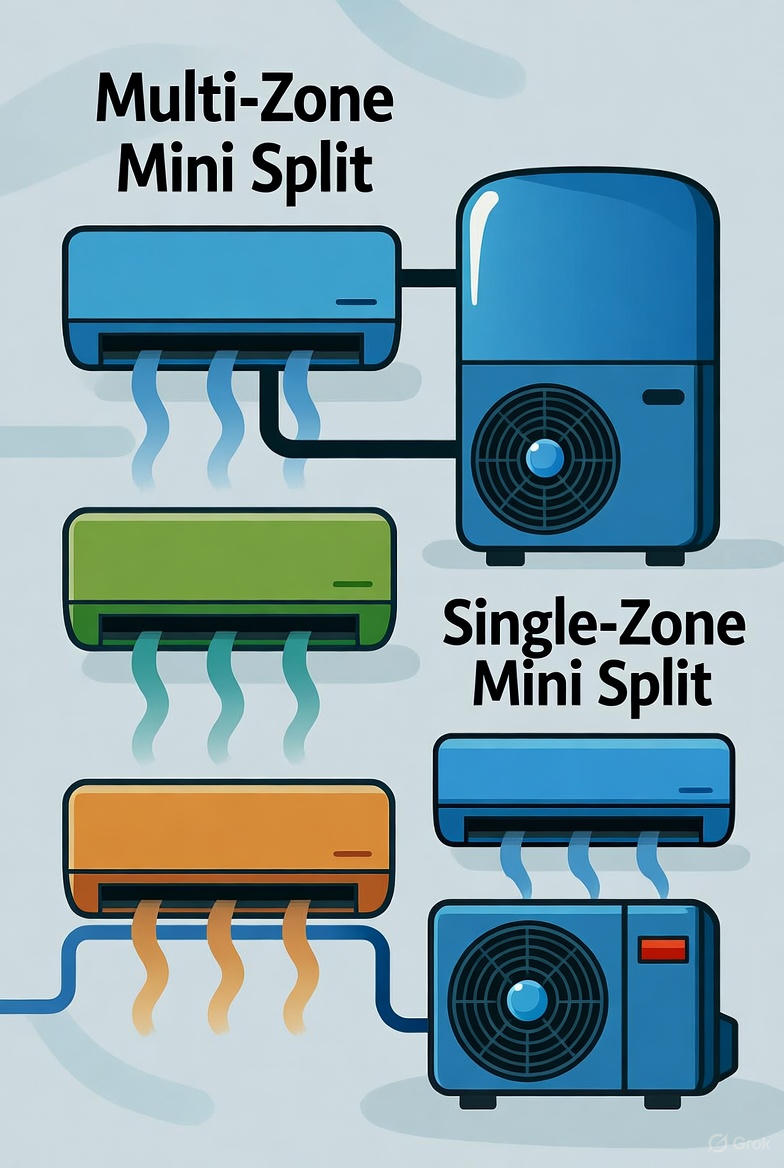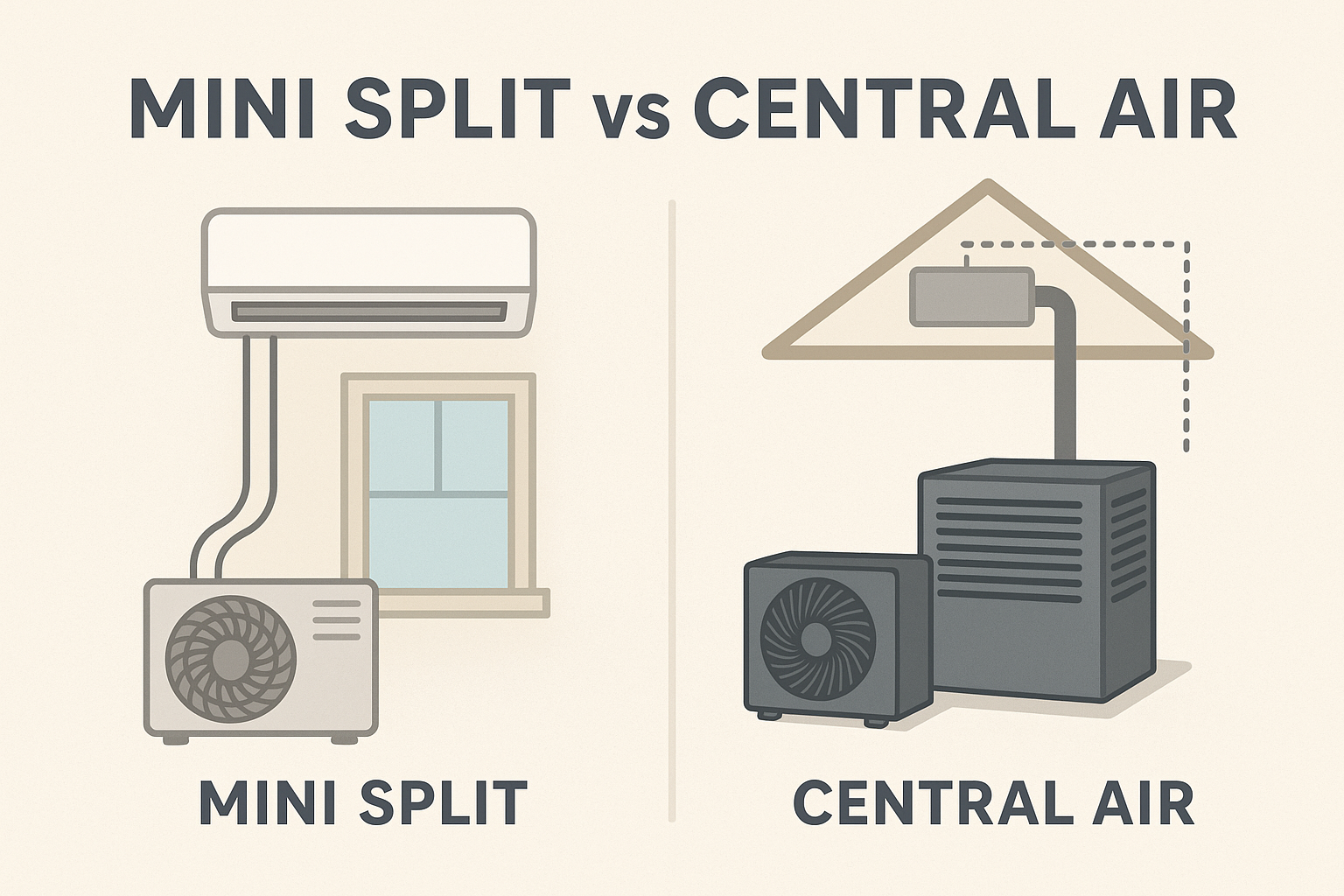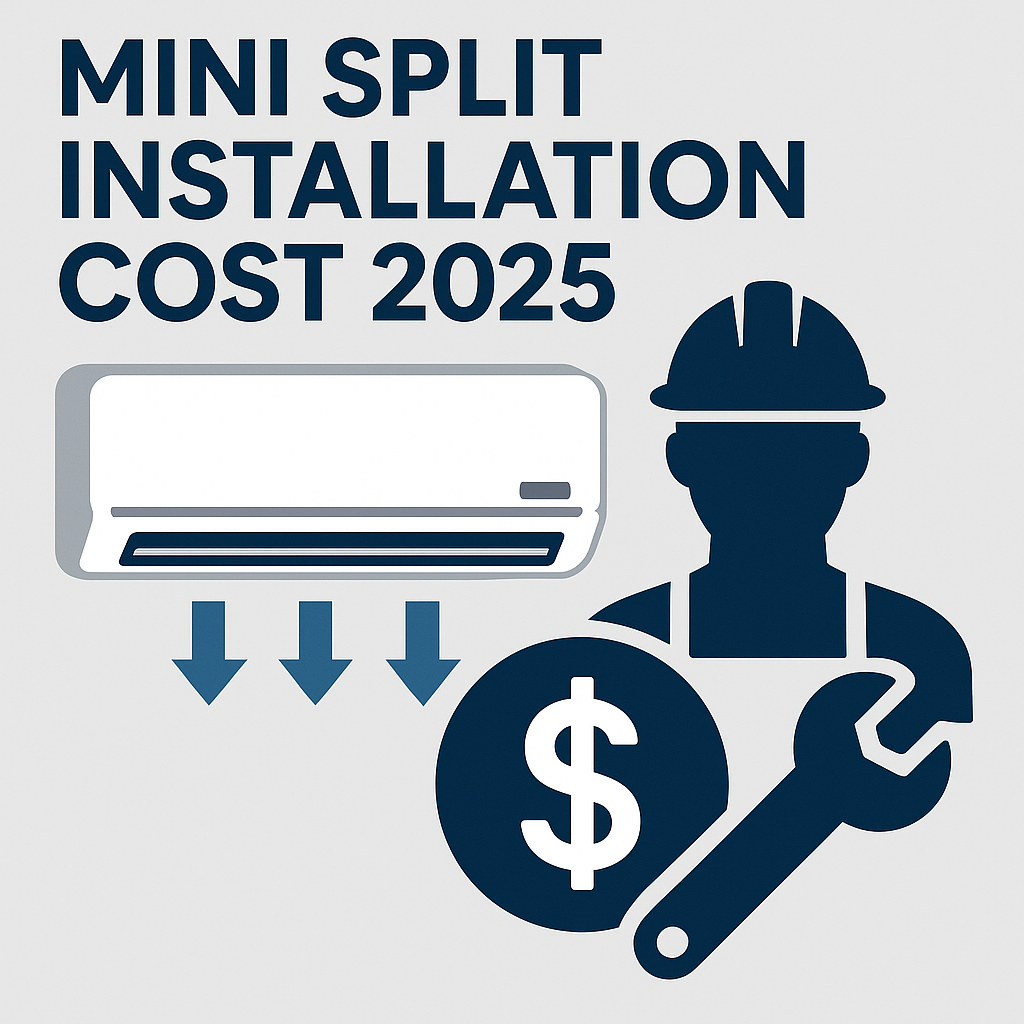Jennifer and Mark Thompson thought they'd made the smart financial decision last spring when choosing a dual-zone mini-split for their Denver two-story home instead of two separate single-zone systems. The equipment savings looked compelling: $3,200 for a 36,000 BTU multi-zone system with two 18,000 BTU indoor units versus $3,600 for two independent 18,000 BTU single-zone systems. Saving $400 seemed like an obvious win, especially since the HVAC contractor emphasized the "cleaner look" of one outdoor unit instead of two.
The system worked beautifully through their first Colorado summer—both the upstairs master bedroom and downstairs living room stayed comfortably cool, their July electric bill came in at $125, and they congratulated themselves on the wise purchase. Then September arrived with Denver's notorious temperature swings, and the fundamental limitation of multi-zone systems revealed itself in frustrating daily reality.
Their south-facing living room with floor-to-ceiling windows would heat to 78°F by 2 PM from afternoon sun, desperately needing cooling. Meanwhile, their north-facing master bedroom on the shaded side of the house stayed a chilly 66°F, requiring heat. The multi-zone system forced them to choose: cool mode for the overheated living room (leaving Mark shivering in the 62°F bedroom), or heat mode for the bedroom (leaving Jennifer sweating in the 82°F living room while working from home). Every day became a negotiation, and someone always ended up uncomfortable.
"We assumed 'dual-zone' meant independent control," Jennifer explained six months later while researching a retrofit solution. "The $400 we saved upfront feels worthless now that we realize we can't heat and cool simultaneously. Our contractor never mentioned this limitation—or maybe he did and we didn't understand the implications until living with it daily." Their October electricity bill jumped to $165 as they ran the system harder trying to find temperature compromises, eliminating their summer efficiency gains. They're now pricing two independent single-zone systems to replace their six-month-old multi-zone—a costly lesson about the difference between lowest upfront cost and best long-term value.
This comprehensive comparison explains exactly what the Thompsons wish they'd understood before purchasing: the critical differences between multi-zone and multiple single-zone systems across cost, efficiency, flexibility, and long-term satisfaction. Whether you're planning a new installation or reconsidering your approach, understanding these factors prevents expensive mistakes.
Understanding the Difference
Single-Zone System:
- 1 outdoor condenser unit
- 1 indoor air handler
- Controls one room/zone
- Independent operation
Multi-Zone System:
- 1 outdoor condenser unit
- 2-8 indoor air handlers
- Controls multiple rooms/zones
- Shared outdoor unit
Multiple Single-Zone Systems:
- 2+ outdoor condenser units
- 2+ indoor air handlers (one per outdoor unit)
- Each room independently controlled
- Completely separate systems
Cost Comparison
Equipment Costs:
Single 12K BTU Zone:
- Outdoor unit: $800
- Indoor unit: $400
- Line set: $100
- Total: $1,300
Dual-Zone 18K+18K:
- Outdoor unit (36K capable): $1,800
- Indoor unit #1 (18K): $600
- Indoor unit #2 (18K): $600
- Line sets (2): $200
- Total: $3,200
Two Separate 18K Single-Zone:
- Outdoor unit #1 (18K): $1,100
- Indoor unit #1 (18K): $600
- Outdoor unit #2 (18K): $1,100
- Indoor unit #2 (18K): $600
- Line sets (2): $200
- Total: $3,600
Savings: Multi-zone $400 less
But scaling changes the equation...
Three-Room Comparison:
Tri-Zone 12K+12K+18K:
- Equipment: $4,200
Three Single-Zone:
- Equipment: $3,900
Savings: Single-zone $300 less
Installation Costs:
Multi-Zone:
- More complex installation
- One outdoor unit location
- Multiple line set runs
- Coordination of zones
- Professional: $2,500-$4,500
- DIY possible but challenging
Multiple Single-Zone:
- Simpler per-unit installation
- Multiple outdoor locations needed
- Independent installations
- Can DIY more easily
- Professional: $800-$1,500 per zone
- DIY: $0 labor (your time)
Operating Efficiency
Multi-Zone Considerations:
Efficiency Loss When Partial Load:
Multi-zone systems face a fundamental challenge: the outdoor unit is sized for maximum capacity (all zones running), but typically operates with only some zones active.
Example: Dual-Zone 18K+18K (36K total capacity)
Scenario 1: Both zones running
- Load: 36K BTU needed
- Capacity: 36K BTU available
- Efficiency: 100% (rated SEER2)
Scenario 2: One zone running (typical)
- Load: 18K BTU needed
- Capacity: 36K unit running at 50%
- Efficiency: 75-85% of rated SEER2
- Energy waste: 15-25%
Why? Inverter compressors are optimized for 40-80% capacity range. Below 40%, efficiency drops significantly.
Single-Zone Advantages:
Each unit optimally matched:
- Room needs 12K? Install 12K unit
- Always operates in sweet spot (40-100%)
- Each zone independently optimized
- No efficiency penalty from other zones
Real-World Data:
Customer: 3-bedroom home, Northeast
Tri-zone configuration:
- 12K + 12K + 18K = 42K total
- Typical use: 1-2 zones at a time
- Average efficiency: ~17 SEER2 (rated 22)
- Monthly bill: $95
Three single-zone:
- 12K + 12K + 18K (separate units)
- Each zone optimally efficient
- Average efficiency: ~21 SEER2
- Monthly bill: $75
Savings: $20/month = $240/year
Flexibility & Control
Multi-Zone Limitations:
1. Simultaneous Mode Requirement
- All zones must be in same mode (heat OR cool)
- Can't cool bedroom while heating living room
- Problem in spring/fall when needs vary
- South-facing rooms may need cooling while north rooms need heat
2. Capacity Limitations
- Can't run all zones at 100% simultaneously
- Multi-zone 36K with two 18K heads ≠ 36K available to each
- Actual: ~70-80% to each when both running
3. Single Point of Failure
- Outdoor unit fails = all zones down
- Repair delays affect entire home
- Higher-stakes if issues occur
Multiple Single-Zone Advantages:
1. True Independence
- Each zone: heat, cool, or fan independently
- Perfect for shoulder seasons
- Ideal for homes with varied sun exposure
- Some rooms occupied, others not
2. Redundancy
- One unit fails? Others keep working
- Critical in extreme weather
- Repair less urgent
- Can prioritize bedroom/living space
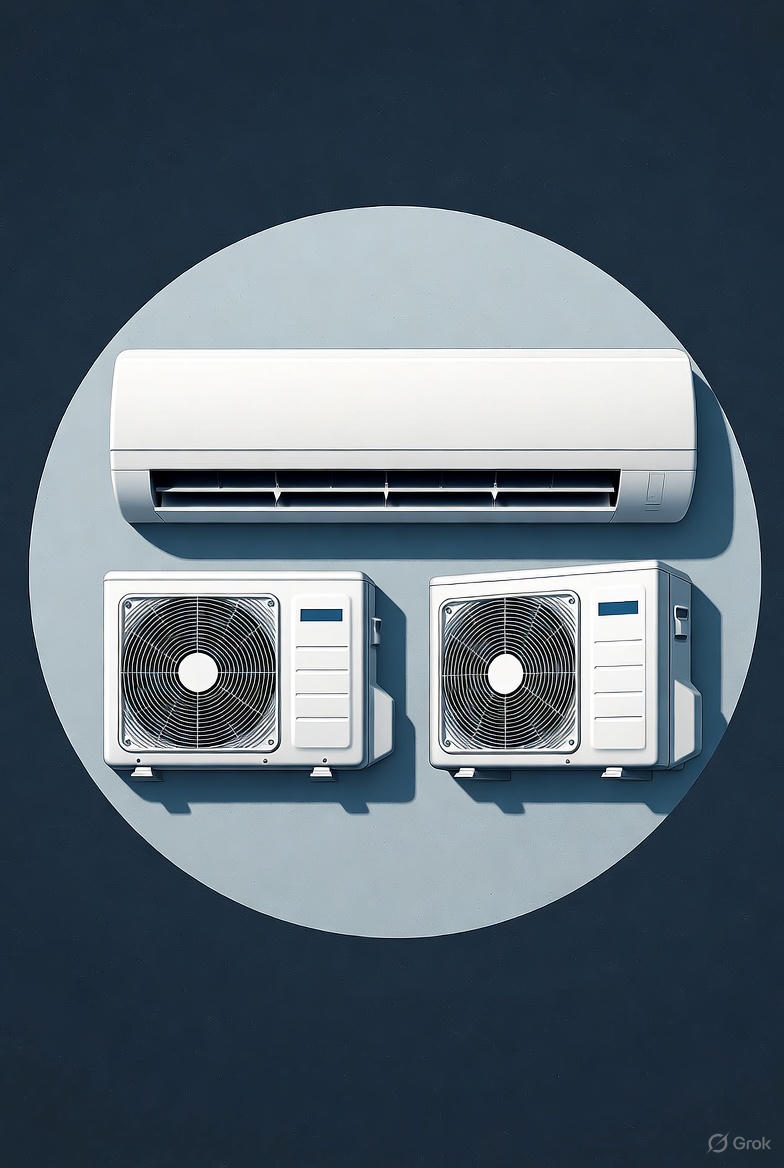
3. Staged Investment
- Buy one zone now
- Add more as budget allows
- Spread cost over time
- No regrets if needs change
4. Easy Expansion
- Add zones anytime
- No outdoor unit capacity limits
- No compatibility concerns
- True flexibility
Installation Considerations
Multi-Zone Challenges:
Outdoor Unit Placement:
- Needs central location
- Longer line set runs possible
- Line set length imbalances
- One location for large unit
Line Set Complexity:
- Multiple runs from one location
- Routing challenges
- Aesthetic considerations
- Professional help often needed
Electrical:
- One large circuit (30-50A typical)
- May require panel upgrade
- Single disconnect
Multi-Zone Benefits:
- Only one outdoor unit
- Less exterior wall space used
- Simpler for apartments/condos
- Cleaner exterior appearance
Multiple Single-Zone Advantages:
Outdoor Unit Placement:
- Each unit near its zone
- Shorter line set runs
- Better efficiency (less distance)
- Easier to hide/distribute
Line Set Simplicity:
- Short, direct runs
- Less wall penetration complexity
- Easier DIY installation
- Better aesthetics (shorter lines)
Electrical:
- Smaller circuits each (15-30A)
- Spread across panel
- Less likely to need upgrade
- Individual disconnects
Multiple Single-Zone Challenges:
- Need space for multiple outdoor units
- More exterior visual impact
- HOA/aesthetic concerns
- Multiple wall penetrations
Maintenance & Repairs
Multi-Zone:
Advantages:
- One outdoor unit to maintain
- Single filter change schedule
- One annual service call
- Lower maintenance costs
Disadvantages:
- Outdoor unit failure catastrophic
- More complex diagnostics
- Expensive repairs (all zones affected)
- Limited DIY repair options
Multiple Single-Zone:
Advantages:
- Failure isolated to one zone
- Simpler diagnostics
- Cheaper per-unit repairs
- Easy DIY maintenance
- Can delay non-critical repairs
Disadvantages:
- Multiple filters to clean
- Multiple outdoor units
- More annual service calls
- Higher total maintenance costs
Repair Cost Example:
Multi-zone compressor failure:
- Part: $800-$1,500
- Labor: $500-$800
- Downtime: All zones
- Total: $1,300-$2,300
Single-zone compressor failure:
- Part: $400-$800
- Labor: $300-$500
- Downtime: One zone
- Total: $700-$1,300
- Other zones unaffected
Lifespan Considerations
Multi-Zone:
Outdoor unit workload:
- Runs frequently (any zone calls)
- Higher cumulative hours
- More wear on compressor
- Typical lifespan: 12-15 years
Indoor units:
- Individual usage varies
- Less-used zones waste energy
- Typical lifespan: 15-20 years
Multiple Single-Zone:
Each outdoor unit:
- Runs only when its zone needs it
- Lower cumulative hours
- Less compressor wear
- Typical lifespan: 15-20 years
System replacement:
- Staggered replacement possible
- Replace as needed, not all at once
- Better long-term value
Room Layout Scenarios
Best for Multi-Zone:
Scenario 1: Open Floor Plan
- Kitchen/dining/living combined
- Need consistent temperature throughout
- Always used together
- Same mode required (cool or heat)
- Multi-zone wins: Treat as one large zone with 2-3 heads
Scenario 2: Apartment/Condo
- Limited exterior wall space
- Only 1-2 outdoor unit locations allowed
- HOA restrictions
- Multi-zone wins: No choice
Scenario 3: Small Home, Always Occupied
- 2-3 rooms total
- Always condition whole home
- Simultaneous mode needs
- Budget-conscious
- Multi-zone wins: Lower upfront cost
Best for Multiple Single-Zone:
Scenario 1: Separate Living Areas
- Bedrooms on one end
- Living space on other
- Different occupancy schedules
- Different sun exposure
- Single-zone wins: True independence
Scenario 2: Phased Installation
- Master bedroom now
- Additional zones later
- Budget constraints
- Uncertain future needs
- Single-zone wins: Flexibility
Scenario 3: Vacation/Part-Time Home
- Only use some rooms
- Efficiency priority
- Rarely condition whole house
- Single-zone wins: Optimal efficiency
Scenario 4: Multi-Story Home
- Different floors
- Different thermal needs
- Varied occupancy
- Single-zone wins: Better control
Hybrid Approach
Best of Both Worlds:
Many homeowners combine both:
Example: Large Home
- Multi-zone for main floor (3 zones)
- Separate single-zone for master suite
- Separate single-zone for garage/workshop
Benefits:
- Main floor: Cost savings, unified control
- Master: Independent heating/cooling
- Garage: Condition only when used
Decision Framework
Choose Multi-Zone If: ✓ All zones used simultaneously ✓ Always need same mode (heat/cool) ✓ Limited outdoor unit space ✓ Lowest upfront cost priority ✓ Open floor plan ✓ 2-3 rooms maximum
Choose Multiple Single-Zone If: ✓ Different zone schedules ✓ Need heat and cool simultaneously ✓ Highest efficiency priority ✓ Phased installation desired ✓ Redundancy important ✓ 4+ rooms needed ✓ DIY installation ✓ Long-term lowest operating cost
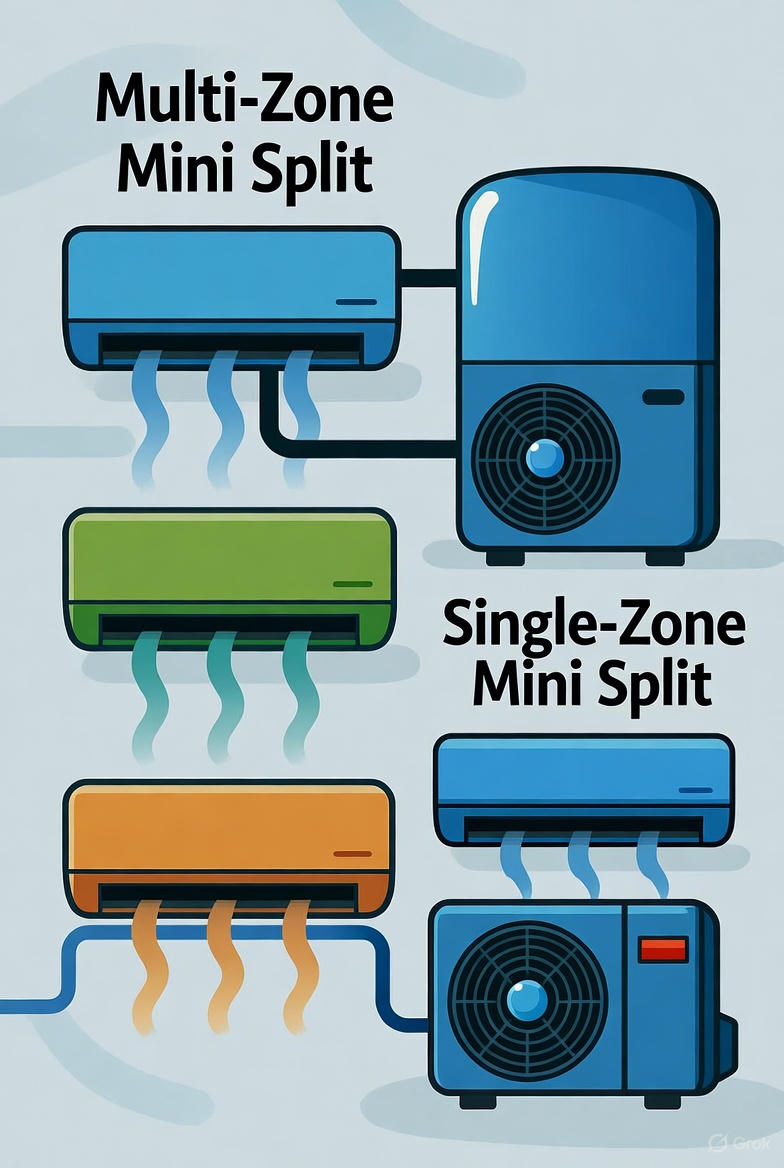
Cost-Benefit Analysis
10-Year Total Cost of Ownership:
Example: 3 Rooms (12K, 12K, 18K)
Multi-Zone:
- Equipment: $4,200
- Installation: $3,500
- Electricity (higher): $1,200/yr × 10 = $12,000
- Maintenance: $150/yr × 10 = $1,500
- Total: $21,200
Multiple Single-Zone:
- Equipment: $3,900
- Installation: $2,400 (DIY possible: $0)
- Electricity (optimized): $950/yr × 10 = $9,500
- Maintenance: $200/yr × 10 = $2,000
- Total: $17,800 (Pro) or $15,400 (DIY)
10-year savings: $3,400-$5,800
But if budget-constrained upfront:
Multi-zone: $7,700 installed Single-zone: $6,300 (DIY) or $8,300 (Pro)
Multi-zone saves $600-$1,000 upfront but costs $3,400-$5,800 more over 10 years.
Real Customer Scenarios
Customer 1: 1,800 sq ft Ranch Chose: 3 separate single-zone units Why: Different sun exposure, phased installation Result: Installed bedrooms first ($2,600), added living room 6 months later ($1,300). Total control, very happy.
Customer 2: 1,200 sq ft Condo Chose: Dual-zone system Why: Only one outdoor location allowed (HOA) Result: Works well, would have preferred singles if possible.
Customer 3: 2,400 sq ft Two-Story Chose: Hybrid (dual-zone downstairs, 2 singles upstairs) Why: Downstairs open, upstairs separate bedrooms Result: Perfect solution, optimized for layout.
Installation Tips
Multi-Zone:
- Size conservatively (won't run all zones at 100%)
- Keep line sets similar length (balance capacity)
- Central outdoor location critical
- Professional installation recommended
- Consider future expansion limitations
Multiple Single-Zone:
- Start with highest-priority zone
- Place outdoor units near indoor units
- Easy to DIY with pre-charged systems
- Spread electrical across panel
- Unlimited future expansion
The Bottom Line
There's no universal "better" choice.
Multi-zone makes sense when:
- You treat multiple rooms as one zone
- Space/HOA limits outdoor units
- Upfront cost is the priority
- Professional installation required anyway
Multiple single-zone makes sense when:
- You want true independence
- Efficiency is the priority
- You'll install DIY
- Redundancy matters
- Phased installation desired
Most common winner: Multiple Single-Zone
For the majority of residential applications, multiple single-zone systems provide:
- Better efficiency (15-25% lower bills)
- More flexibility (independent control)
- Lower risk (redundancy)
- Easier installation (DIY-friendly)
- Better long-term value (staggered replacement)
The multi-zone upfront savings ($400-$1,000) are quickly erased by higher operating costs and reduced flexibility.
Our Recommendation:
Start with one high-priority zone. See how it performs. Add more as needed. This approach:
- Minimizes upfront investment
- Maximizes flexibility
- Allows learning before committing
- Provides redundancy
- Optimizes efficiency
Frequently Asked Questions
Is a multi-zone mini split more efficient than multiple single-zones?
No—multiple single-zone systems are typically 15-25% more efficient than multi-zone systems due to independent operation and optimized sizing for each space. Multi-zone systems force all connected zones to operate whenever any single zone calls for conditioning, wasting energy conditioning spaces that don't need it. If your bedroom needs cooling but your living room is already comfortable, a multi-zone runs both indoor units plus the oversized outdoor condenser. Multiple single-zones cool only the bedroom, using just that room's appropriately-sized equipment. The efficiency gap compounds in mild weather when spaces need minimal conditioning—multi-zone systems can't optimize for one zone's part-load operation without affecting others. Real-world data from a 3-zone home in moderate climate shows multi-zone annual electricity costs of $780 versus $590 for three single-zones—$190 annual savings that total $2,850 over 15 years. The multi-zone's $800 upfront cost advantage disappears by year 5, after which single-zones deliver superior lifetime value. Inverter technology helps multi-zone efficiency by varying capacity, but physics still favors independent systems running exactly when and where needed. For maximum efficiency, choose single-zones for any rooms with different occupancy schedules, sun exposure, or temperature preferences.
Can you mix heating and cooling with a multi-zone system?
No—multi-zone systems operate in either heating OR cooling mode, never both simultaneously. All connected zones must run the same mode at the same time, creating frustration in spring and fall when one room needs cooling while another needs heating. A south-facing home office might overheat from afternoon sun requiring AC, while a north-facing bedroom stays cool needing heat. Multi-zone forces you to choose one mode, leaving someone uncomfortable. Multiple single-zone systems solve this completely—each operates independently in the mode its space requires. Your office cools while your bedroom heats, everyone stays comfortable, and you don't waste energy overcooling the bedroom or overheating the office trying to compromise. This simultaneous heating/cooling limitation represents multi-zone's biggest practical drawback, affecting homeowners daily during shoulder seasons (March-May, September-November in most climates). Multi-story homes face this issue most severely, as upper floors heat from rising warm air while lower floors stay cooler. Commercial spaces with varied occupancy and sun exposure encounter the same problem. If your home experiences temperature variations between rooms, or you have family members with different comfort preferences, multiple single-zones are essential.
How many zones can you run on a multi-zone system?
Multi-zone systems support 2-8 indoor units depending on outdoor condenser capacity, but practical limits make 2-4 zones optimal for most residential applications. The critical factor is total indoor capacity versus outdoor capacity—most multi-zone systems allow indoor units totaling 120-130% of outdoor capacity, assuming not all zones run at maximum simultaneously. For example, a 36,000 BTU outdoor unit can support up to 42,000-48,000 BTU of indoor capacity across multiple heads. Installing more zones means smaller individual units per room, increasing the risk of undersizing for peak conditions. A 3-zone system splitting 36K BTU gets approximately 12K per zone, adequate for most rooms. Stretching to 5 zones drops each to just 7-8K BTU—undersized for many spaces. System performance degrades as zone count increases because the outdoor unit must constantly balance competing demands, refrigerant flow gets more complex requiring longer stabilization times, and efficiency drops from managing multiple zone valves and sensors. Most manufacturers recommend maximum 4 zones for optimal efficiency and reliability. Beyond 4 zones, consider multiple multi-zone systems or switch to all single-zones. Installation complexity also increases with zone count—more refrigerant lines to route, more condensate drains to install, and more potential failure points. For whole-home conditioning, hybrid approaches often work best: one multi-zone for the main floor, separate single-zones for outlying spaces.
Is it cheaper to install multi-zone or multiple single-zones?
Multi-zone systems cost less upfront ($400-$1,200 savings for 3 zones) but multiple single-zones prove cheaper over 10+ year ownership due to lower operating costs and staggered replacement. Initial installation of three zones professionally costs $6,800-$11,000 for multi-zone versus $9,500-$13,500 for three single-zones—multi-zone saves $800-$2,700 initially. However, operating costs favor single-zones: $590 annually versus $780 for multi-zone ($190 yearly savings). By year 5, cumulative savings erase the upfront multi-zone advantage. Over 15 years, single-zones cost $13,350 total (equipment plus electricity) versus multi-zone's $14,500—single-zones become cheaper while delivering superior flexibility and efficiency. DIY installation magnifies single-zone advantages. Three Zone single-zone systems cost $6,000-$7,500 DIY total versus $8,000-$10,000 DIY for comparable multi-zone equipment. With DIY, single-zones cost less upfront AND long-term. System replacement considerations matter too—when a multi-zone outdoor unit fails after 15 years, you replace the entire system ($4,000-$6,000). When one single-zone fails, you replace only that unit ($2,000-$2,800), continuing to use the others. Spread three single-zone replacements over years 15-20, and your 20-year cost for single-zones beats multi-zone by $3,000-$5,000. The financial winner depends on your timeline: choose multi-zone for lowest upfront cost with professional installation and 5-year ownership, or choose single-zones for lowest lifetime cost with DIY installation and 10+ year ownership.
Can you add more zones to a multi-zone system later?
Only if you initially purchased an outdoor unit with unused capacity—most multi-zone installations max out all ports immediately, making expansion impossible without complete outdoor unit replacement. Multi-zone outdoor units come with 2, 3, 4, or 5 refrigerant ports. If you buy a 3-port unit and connect three indoor units, all ports are used—adding a fourth zone requires replacing the outdoor unit entirely ($3,000-$5,000). Smart planning leaves one port unused for future expansion, but this means oversizing your initial outdoor unit by 25-30%, reducing efficiency and increasing upfront costs. Even with an available port, adding zones later requires refrigerant recharging, system rebalancing, potential electrical upgrades, and professional service ($800-$1,500 for the add-on zone). Compare this to single-zone expansion: simply purchase another complete single-zone system and install it independently—no impact on existing systems, no professional rebalancing required, full DIY installation possible. The expansion flexibility of single-zones provides tremendous value for growing families, uncertain future needs, or phased installations to spread costs over time. Start with your highest-priority room, verify you're satisfied with mini-split comfort, then add more zones at your own pace. This approach also future-proofs against technology improvements—your second zone three years later might offer better efficiency or features than your first zone. With multi-zone, you're locked into your initial technology choice for all zones.
Do multi-zone systems last as long as single-zones?
Multi-zone outdoor units typically last 12-15 years versus 15-20 years for single-zone systems due to higher complexity and constant operation. Multi-zone condensers contain more complex refrigerant flow controls, electronic zone valves, additional sensors and wiring, and must constantly balance competing zone demands—all increasing failure points and reducing lifespan. Even when one zone needs minimal conditioning, the outdoor unit must operate to serve it, accumulating runtime unnecessarily. Single-zone systems shut down completely when their space reaches temperature, extending compressor life through reduced cycling and total runtime. Maintenance complexity also affects longevity—multi-zone systems require professional service for refrigerant rebalancing and zone valve diagnostics, while single-zones use straightforward DIY maintenance. When multi-zone systems fail, the single outdoor unit failure disables all connected zones until professional repair—potentially days or weeks without comfort in multiple rooms. Single-zone failures affect only that zone, leaving others operational. This redundancy proves valuable during peak summer or winter when HVAC failures create uncomfortable or dangerous conditions. Replacement economics favor single-zones too: when a multi-zone system reaches end-of-life around year 13-15, you replace everything simultaneously ($4,000-$7,000). Three single-zone systems naturally fail at staggered intervals over years 15-20, spreading replacement costs and allowing you to replace with the latest technology as each fails.
Which is better for a whole house: multi-zone or multiple single-zones?
For whole-house conditioning, multiple single-zones deliver superior performance, efficiency, and long-term value for most homeowners despite higher upfront costs. Whole-house applications magnify the advantages of independent zone control—bedrooms, living spaces, kitchens, and offices all have different occupancy schedules and temperature needs throughout the day. Single-zones let you cool bedrooms at night while the unoccupied main floor stays unconditioned, then flip this during daytime hours. Multi-zone forces simultaneous operation, wasting energy conditioning empty bedrooms all day and unoccupied living spaces all night. The efficiency difference compounds over years: a 2,000 square foot home with 4 single-zones costs approximately $850 annually to operate versus $1,150 for a comparable 4-zone multi-zone system—$300 yearly savings total $4,500 over 15 years. Reliability matters more in whole-house applications because system failure affects your entire home comfort. One multi-zone outdoor unit failure disables heating and cooling for your entire house. Four single-zones provide redundancy—if one fails, three remain operational. Installation flexibility favors single-zones too: place outdoor units optimally for each zone rather than finding one central location for a massive multi-zone condenser. The only scenarios where multi-zone makes sense for whole-house are apartment/condo HOA restrictions limiting outdoor units, homes with literally no wall space for multiple outdoor units, or professional installation with very tight budget prioritizing lowest upfront cost. For DIY homeowners, long-term ownership, or anyone prioritizing efficiency and flexibility, single-zones win decisively for whole-house applications.
Ready to get started? Check out Zone's single-zone systems or call (801) 882-2324 to discuss your specific layout and needs.
Still unsure? Use our sizing calculator to determine capacity needs for each room.
About the Author: Thomas Johnson is a Sales & Customer Success Specialist at Zone Air with a background in business and competitive strategy. Drawing from his experience in rugby, where teamwork and strategic planning are essential, Thomas applies the same principles to helping customers find the perfect HVAC solution for their needs. He specializes in product comparisons, brand analysis, and matching customers with systems that deliver the best value for their specific situation. Thomas's consultative approach ensures customers understand their options clearly and make confident purchasing decisions. When not helping homeowners upgrade their comfort, you'll find him on the rugby pitch developing the same strategic thinking he brings to customer consultations.


